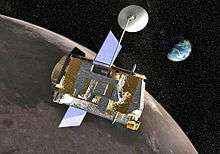Exploration of the Moon
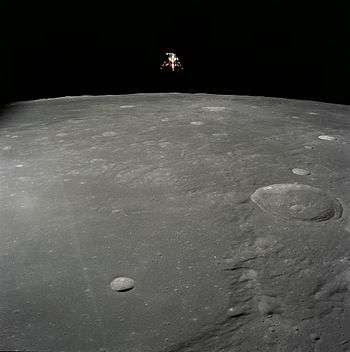
The physical exploration of the Moon began when Luna 2, a space probe launched by the Soviet Union, made an impact on the surface of the Moon on September 14, 1959. Prior to that the only available means of exploration had been observation from Earth. The invention of the optical telescope brought about the first leap in the quality of lunar observations. Galileo Galilei is generally credited as the first person to use a telescope for astronomical purposes; having made his own telescope in 1609, the mountains and craters on the lunar surface were among his first observations using it.
NASA's Apollo program was the first, and to date only, mission to successfully land humans on the Moon, which it did six times. The first landing took place in 1969, when astronauts placed scientific instruments and returned lunar samples to Earth.
Early history
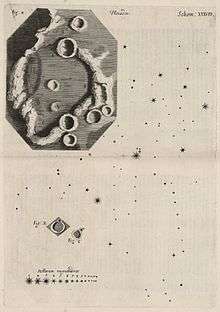
The ancient Greek philosopher Anaxagoras (d. 428 BC) reasoned that the Sun and Moon were both giant spherical rocks, and that the latter reflected the light of the former. His non-religious view of the heavens was one cause for his imprisonment and eventual exile.[1] In his little book On the Face in the Moon's Orb, Plutarch suggested that the Moon had deep recesses in which the light of the Sun did not reach and that the spots are nothing but the shadows of rivers or deep chasms. He also entertained the possibility that the Moon was inhabited. Aristarchus went a step further and computed the distance from Earth, together with its size, obtaining a value of 20 times the Earth radius for the distance (the real value is 60; the Earth radius was roughly known since Eratosthenes).
Although the Chinese of the Han Dynasty (202 BC–202 AD) believed the Moon to be energy equated to qi, their 'radiating influence' theory recognized that the light of the Moon was merely a reflection of the Sun (mentioned by Anaxagoras above).[2] This was supported by mainstream thinkers such as Jing Fang,[2] who noted the sphericity of the Moon.[2] Shen Kuo (1031–1095) of the Song Dynasty (960–1279) created an allegory equating the waxing and waning of the Moon to a round ball of reflective silver that, when doused with white powder and viewed from the side, would appear to be a crescent.[2]
By 499 AD, the Indian astronomer Aryabhata mentioned in his Aryabhatiya that reflected sunlight is the cause behind the shining of the Moon.[3]
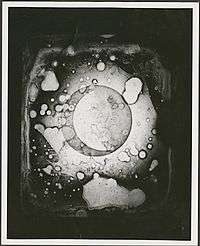

Habash al-Hasib al-Marwazi, a Persian astronomer, conducted various observations at the Al-Shammisiyyah observatory in Baghdad between 825 and 835 AD.[4] Using these observations, he estimated the Moon's diameter as 3,037 km (equivalent to 1,519 km radius) and its distance from the Earth as 346,345 km (215,209 mi), which come close to the currently accepted values.[4] In the 11th century, the Islamic physicist, Alhazen, investigated moonlight, which he proved through experimentation originates from sunlight and correctly concluded that it "emits light from those portions of its surface which the sun's light strikes."[5]
By the Middle Ages, before the invention of the telescope, an increasing number of people began to recognise the Moon as a sphere, though many believed that it was "perfectly smooth".[6] In 1609, Galileo Galilei drew one of the first telescopic drawings of the Moon in his book Sidereus Nuncius and noted that it was not smooth but had mountains and craters. Later in the 17th century, Giovanni Battista Riccioli and Francesco Maria Grimaldi drew a map of the Moon and gave many craters the names they still have today. On maps, the dark parts of the Moon's surface were called maria (singular mare) or seas, and the light parts were called terrae or continents.
Thomas Harriot, as well as Galilei, drew the first telescopic representation of the Moon and observed it for several years. His drawings, however, remained unpublished.[7] The first map of the Moon was made by the Belgian cosmographer and astronomer Michael Florent van Langren in 1645.[7] Two years later a much more influential effort was published by Johannes Hevelius. In 1647 Hevelius published Selenographia, the first treatise entirely devoted to the Moon. Hevelius's nomenclature, although used in Protestant countries until the eighteenth century, was replaced by the system published in 1651 by the Jesuit astronomer Giovanni Battista Riccioli, who gave the large naked-eye spots the names of seas and the telescopic spots (now called craters) the name of philosophers and astronomers.[7] In 1753 the Croatian Jesuit and astronomer Roger Joseph Boscovich discovered the absence of atmosphere on the Moon. In 1824 Franz von Gruithuisen explained the formation of craters as a result of meteorite strikes.[8]
The possibility that the Moon contains vegetation and is inhabited by selenites was seriously considered by major astronomers even into the first decades of the 19th century. In 1834–1836, Wilhelm Beer and Johann Heinrich Mädler published their four-volume Mappa Selenographica and the book Der Mond in 1837, which firmly established the conclusion that the Moon has no bodies of water nor any appreciable atmosphere.
Space race
The Cold War-inspired "space race" and "Moon race" between the Soviet Union and the United States of America accelerated with a focus on the Moon. This included many scientifically important firsts, such as the first photographs of the then-unseen far side of the Moon in 1959 by the Soviet Union, and culminated with the landing of the first humans on the Moon in 1969, widely seen around the world as one of the pivotal events of the 20th century, and indeed of human history in general.
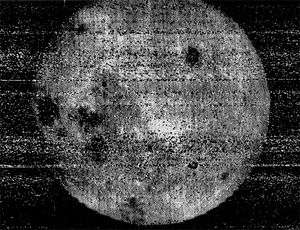
.jpg)
The first man-made object to reach the Moon was the unmanned Soviet probe Luna 2, which made a hard landing on September 14, 1959, at 21:02:24 Z. The far side of the Moon was first photographed on October 7, 1959, by the Soviet probe Luna 3. Though vague by today's standards, the photos showed that the far side of the Moon almost completely lacked maria. In an effort to compete with these Soviet successes, U.S. President John F. Kennedy proposed the national goal of landing a human on the Moon. Speaking to a Joint Session of Congress on May 25, 1961, he said
"First, I believe that this nation should commit itself to achieving the goal, before this decade is out, of landing a man on the Moon and returning him safely to the earth. No single space project in this period will be more impressive to mankind, or more important for the long-range exploration of space."[9]
The Soviets nonetheless remained in the lead for some time. Luna 9 was the first probe to soft land on the Moon and transmit pictures from the lunar surface on February 3, 1966. It was proven that a lunar lander would not sink into a thick layer of dust, as had been feared. The first artificial satellite of the Moon was the Soviet probe Luna 10, launched March 31, 1966.
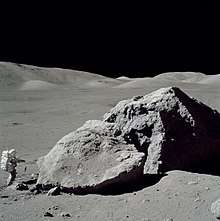
On December 24, 1968, the crew of Apollo 8, Frank Borman, James Lovell and William Anders, became the first human beings to enter lunar orbit and see the far side of the Moon in person. Humans first landed on the Moon on July 20, 1969. The first human to walk on the lunar surface was Neil Armstrong, commander of the U.S. mission Apollo 11. The first robot lunar rover to land on the Moon was the Soviet vessel Lunokhod 1 on November 17, 1970, as part of the Lunokhod programme. To date, the last human to stand on the Moon was Eugene Cernan, who as part of the mission Apollo 17, walked on the Moon in December 1972. See also: A full list of lunar Apollo astronauts.
Moon rock samples were brought back to Earth by three Luna missions (Luna 16, 20, and 24) and the Apollo missions 11 through 17 (except Apollo 13, which aborted its planned lunar landing).
From the mid-1960s to the mid-1970s there were 65 Moon landings (with 10 in 1971 alone), but after Luna 24 in 1976 they suddenly stopped. The Soviet Union started focusing on Venus and space stations and the U.S. on Mars and beyond, and on the Skylab and Space Shuttle programs.
Before the Moon race the US had pre-projects for scientific and military moonbases: the Lunex Project and Project Horizon. Besides manned landings, the abandoned Soviet manned lunar programs included the building of a multipurpose moonbase "Zvezda", the first detailed project, complete with developed mockups of expedition vehicles[10] and surface modules.[11]
Recent exploration
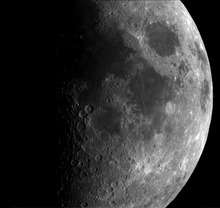
In 1990 Japan visited the Moon with the Hiten spacecraft, becoming the third country to place an object in orbit around the Moon. The spacecraft released the Hagoromo probe into lunar orbit, but the transmitter failed, thereby preventing further scientific use of the spacecraft. In September 2007, Japan launched the SELENE spacecraft, with the objectives "to obtain scientific data of the lunar origin and evolution and to develop the technology for the future lunar exploration", according to the JAXA official website.[12]
The European Space Agency launched a small, low-cost lunar orbital probe called SMART 1 on September 27, 2003. SMART 1's primary goal was to take three-dimensional X-ray and infrared imagery of the lunar surface. SMART 1 entered lunar orbit on November 15, 2004 and continued to make observations until September 3, 2006, when it was intentionally crashed into the lunar surface in order to study the impact plume.[13]
China has begun the Chinese Lunar Exploration Program for exploring the Moon and is investigating the prospect of lunar mining, specifically looking for the isotope helium-3 for use as an energy source on Earth.[14] China launched the Chang'e 1 robotic lunar orbiter on October 24, 2007. Originally planned for a one-year mission, the Chang'e 1 mission was very successful and ended up being extended for another four months. On March 1, 2009, Chang'e 1 was intentionally impacted on the lunar surface completing the 16-month mission. On October 1, 2010, China launched the Chang'e 2 lunar orbiter. China landed the rover Chang'e 3 on the Moon on December 14, 2013, became the third country to have done so.[15] Chang'e 3 is the first spacecraft to soft-land on lunar surface since Luna 24 in 1976.
India's national space agency, Indian Space Research Organisation (ISRO), launched Chandrayaan-1, an unmanned lunar orbiter, on October 22, 2008.[16] The lunar probe was originally intended to orbit the Moon for two years, with scientific objectives to prepare a three-dimensional atlas of the near and far side of the Moon and to conduct a chemical and mineralogical mapping of the lunar surface.[17][18] The unmanned Moon Impact Probe landed on the Moon at 15:04 GMT on November 14, 2008 [19] making India the fourth country to touch down on the lunar surface. Among its many achievements was the discovery of the widespread presence of water molecules in lunar soil.[20]

Lunar Reconnaissance Orbiter · Moon
The Ballistic Missile Defense Organization and NASA launched the Clementine mission in 1994, and Lunar Prospector in 1998. NASA launched the Lunar Reconnaissance Orbiter, on June 18, 2009, which has collected imagery of the Moon's surface. It also carried the Lunar Crater Observation and Sensing Satellite (LCROSS), which investigated the possible existence of water in Cabeus crater. GRAIL is another mission, launched in 2011.
The first commercial mission to the Moon was accomplished by the Manfred Memorial Moon Mission (4M), led by LuxSpace, an affiliate of German OHB AG. The mission was launched on 23 October 2014 with the Chinese Chang'e 5-T1 test spacecraft, attached to the upper stage of a Long March 3C/G2 rocket.[21][22] The 4M spacecraft made a Moon flyby on a night of 28 October 2014, after which it entered elliptical Earth orbit, exceeding its designed lifetime by four times.[23][24]
Plans
Following the abandoned US Constellation program, plans for manned flights followed by moonbases were declared by Russia, Europe (ESA), China, Japan and India. All of them intend to continue the exploration of Moon with more unmanned spacecraft.
China planned to conduct a sample return mission with its Chang'e 5 spacecraft in 2017, but that mission has been postponed until 2019 due to the 2017 failure of the Long March 5 launch vehicle.[25] It will also send Chang'e 4, the backup model of the Chang'e 3 lander) to the lunar farside in 2018.[26] Since the Chang'e 3 mission was a success, the backup lander Chang'e 4 is re-purposed for the mission to the farside, which will be the first time it is attempted by any of the space faring countries.
India expects to launch another lunar mission by 2018, the Chandrayaan-2, which would place a motorized rover on the Moon.[27]
Japanese Aerospace Exploration Agency (JAXA) plans a manned lunar landing around 2020 that would lead to a manned lunar base by 2030; however, there is no budget yet for this project and the plan reverts to robotic missions.[28]
Russia also announced to resume its previously frozen project Luna-Glob, an unmanned lander and orbiter, which is slated to launch in 2016.[29] In 2015, Roscosmos stated that Russia plans to place an astronaut on the Moon by 2030 leaving Mars to NASA. The purpose is to work jointly with NASA and avoid a space race[30]
Germany also announced in March 2007 that it would launch a national lunar orbiter, LEO in 2012.[31] However the mission was cancelled due to budgetary constraints.[32]
In August 2007, NASA stated that all future missions and explorations of the Moon will be done entirely using the metric system. This was done to improve cooperation with space agencies of other countries which already use the metric system.[33]
The European Space Agency has also announced its intention to send a manned mission to the Moon, as part of the Aurora programme. In September 2010, the agency introduced a "Lunar lander" programme with a target of autonomous mission to the Moon in 2018.[34]
On September 13, 2007, the X Prize Foundation, in concert with Google, Inc., announced the Google Lunar X Prize. This contest requires competitors "to land a privately funded robotic rover on the Moon that is capable of completing several mission objectives, including roaming the lunar surface for at least 500 meters and sending video, images and data back to the Earth."[35]
In March 2014, SpaceX indicated that while their current focus is not on Lunar space transport, they will consider commercial launch contracts for one-off Moon missions.[36]
Russian Federation spacecraft is planned to send cosmonauts to the moon orbit in 2025.[37] Russian Lunar Orbital Station is then proposed to orbit around the Moon after 2030.
Timeline of Moon exploration
| Mission (1950–1959) | Launch | Arrival at Moon | Termination | Objective | Scientific result |
|---|---|---|---|---|---|
| 17 August 1958 | 17 August 1958 | Orbiter | Launch failure (Thor first stage) | ||
| 23 September 1958 | 23 September 1958 | Impactor | Launch failure | ||
| 11 October 1958 | 13 October 1958 | Orbiter | Launch failure | ||
| 11 October 1958 | 11 October 1958 | Impactor | Launch failure | ||
| 8 November 1958 | 8 November 1958 | Orbiter | Launch failure | ||
| 4 December 1958 | 4 December 1958 | Impactor | Launch failure | ||
| 6 December 1958 | 7 December 1959 | Flyby | Launch failure | ||
(Mechta, Dream, E-1 No.4) | 2 January 1959 | 4 January 1959 | Impactor | Partial success (first successful flyby 5,995 km, shown Moon's magnetic field absence) | |
| 3 March 1959 | 4 March 1959 | 7 March 1959 | Flyby | Partial success (flyby 60,000 km) | |
| 18 June 1959 | 18 June 1959 | Impactor | Launch failure | ||
| 12 September 1959 | 13 September 1959 | Impactor | Success (first spacecraft reaching the Moon surface, impacted east of Mare Serenitatis, discovered time variations in the electron flux and energy spectrum in the Van Allen radiation belt) | ||
| 24 September 1959 | 24 September 1959 | Orbiter | Launch failure | ||
| 4 October 1959 | 6 October 1959 | Flyby | Success (first pictures of Moon far side) | ||
| 26 November 1959 | 26 November 1959 | Orbiter | Launch failure | ||
| Mission (1960–1969) | Launch | Arrival at Moon | Termination | Objective | Result |
| 15 April 1960 | 15 April 1960 | Flyby | Launch failure | ||
| 16 April 1960 | 16 April 1960 | Flyby | Launch failure | ||
| 25 September 1960 | 25 September 1960 | Orbiter | Launch failure | ||
| 15 December 1960 | 15 December 1960 | Orbiter | Launch failure | ||
| 26 January 1962 | 28 January 1962 | Impactor | Failure (flyby) | ||
| 23 April 1962 | 26 April 1962 | 26 April 1962 | Impactor | Failure (no mid-course correction, crashed at Moon far-side) | |
| 18 October 1962 | 21 October 1962 | Impactor | Failure (flyby) | ||
| 4 January 1963 | 11 January 1963 | Lander | Launched into wrong orbit | ||
| 3 February 1963 | 3 February 1963 | Lander | Launch failure | ||
| 2 April 1963 | >6 April 1963 | Lander | Failure (flyby) | ||
| 30 January 1964 | 2 February 1964 | 2 February 1964 | Impactor | Failure (TV camera, only instrument, did not work) | |
| 21 March 1964 | 21 March 1964 | Lander | Launch failure | ||
| 20 April 1964 | 20 April 1964 | Lander | Launch failure | ||
| 28 July 1964 | 31 July 1964 | Impactor | Success | ||
| 17 February 1965 | 20 February 1965 | Impactor | Success | ||
| 12 March 1965 | Lander | Failed to leave Earth orbit | |||
| 21 March 1965 | 24 March 1965 | Impactor | Success | ||
| 10 April 1965 | 10 April 1965 | Lander | Launch failure | ||
| 9 May 1965 | 12 May 1965 | Lander | Failure (crashed at Sea of Clouds) | ||
| 8 June 1965 | 11 June 1965 | Lander | Failure (flyby) | ||
| 18 July 1965 | 20 July 1965 | Flyby | Success | ||
| 4 October 1965 | 7 October 1965 | Lander | Failure (crashed at Oceanus Procellarum) | ||
| 3 December 1965 | 6 December 1965 | Lander | Failure (crashed at Oceanus Procellarum) | ||
| 31 January 1966 | 3 February 1966 | 6 February 1966 | Lander | Success (first spacecraft to achieve a soft landing and first pictures from Moon surface, landed at Oceanus Procellarum) | |
| 1 March 1966 | 3 March 1966 | Orbiter | Launched into wrong orbit | ||
| 31 March 1966 | 3 April 1966 | 30 May 1966 | Orbiter | Success (first lunar orbiter) | |
| 30 May 1966 | 2 June 1966 | 7 January 1967 | Lander | Success (landed at Oceanus Procellarum) | |
| 10 August 1966 | 14 August 1966 | 29 October 1966 | Orbiter | Success | |
| 24 August 1966 | 27 August 1966 | 1 October 1966 | Orbiter | Success | |
| 20 September 1966 | 23 September 1966 | 23 September 1966 | Lander | Failure (crashed near Copernicus crater) | |
| 22 October 1966 | 25 October 1966 | 19 January 1967 | Orbiter | Success | |
| 6 November 1966 | 10 November 1966 | 11 October 1967 | Orbiter | Success | |
| 21 December 1966 | 24 December 1966 | 28 December 1966 | Lander | Success (landed at Oceanus Procellarum) | |
| 5 February 1967 | 8 February 1967 | 9 October 1967 | Orbiter | Partial success (picture acquisition cut short) | |
| 17 April 1967 | 20 April 1967 | 3 May 1967 | Lander | Success (portions subsequently retrieved by Apollo 12 astronauts) | |
| 4 May 1967 | 8 May 1967 | <31 October 1967 | Orbiter | Partial success (picture acquisition cut short) | |
| 14 July 1967 | 17 July 1967 | 17 July 1967 | Lander | Failure (may have exploded before reaching surface) | |
| 1 August 1967 | 5 August 1967 | 31 January 1968 | Orbiter | Success | |
| 8 September 1967 | 11 September 1967 | 17 December 1967 | Lander | Success | |
| 7 November 1967 | 10 November 1967 | 14 December 1967 | Lander | Success | |
| 7 January 1968 | 10 January 1968 | 20 February 1968 | Lander | Success | |
| 7 February 1968 | 7 February 1968 | Lander | Launch failure | ||
| 7 April 1968 | 10 April 1968 | 4 July 1968 | Orbiter | Success | |
| 15 September 1968 | 18 September 1968 | 21 September 1968 | Flyby | Success (first spacecraft and living beings to return to Earth from lunar flyby) | |
| 10 November 1968 | 14 November 1968 | 17 November 1968 | Flyby | Partial success (depressurisation lead to biologicals death, crashed due to failure in parachute) | |
| 21 December 1968 | 24 December 1968 | 27 December 1968 | Orbiter | Success (first manned lunar orbiter) | |
| 19 February 1969 | 19 February 1969 | Rover | Launch failure | ||
| 18 May 1969 | 21 May 1969 | 26 May 1969 | Orbiter | Success (lander test in Moon orbit) | |
| 14 June 1969 | 14 June 1969 | Sample return | Launch failure | ||
| 13 July 1969 | 21 July 1969 | Sample return | Failure (crashed at Mare Crisium) | ||
| 16 July 1969 | 18 July 1969 | 24 July 1969 | Orbiter | Success | |
| 20 July 1969 | 21 July 1969 | Sample return | Success (21.5 kg of lunar rocks retrieved, first humans on the Moon surface) | ||
| 7 August 1969 | 11 August 1969 | 14 August 1969 | Flyby | Success | |
| 23 September 1969 | 23 September 1969 | Sample return | Launched into wrong orbit | ||
| 22 October 1969 | 22 October 1969 | Sample return | Launched into wrong orbit | ||
| 14 November 1969 | 17 November 1969 | 24 November 1969 | Orbiter | Success | |
| 19 November 1969 | 20 November 1969 | Sample return | Success (First precise landing, recovered parts from Surveyor 3) | ||
| Mission (1970–1979) | Launch | Arrival at Moon | Termination | Objective | Result |
| 11 April 1970 | 15 April 1970 | 17 April 1970 | Sample return | Failure (flyby, crew returned to Earth) | |
| 14 April 1970 | 14 April 1970 | Impactor | Success (provided signal for the Apollo 12 Passive Seismic Experiment) | ||
| 6 February 1970 | 6 February 1970 | Sample return | Launch failure | ||
| 12 September 1970 | 20 September 1970 | 24 September 1970 | Sample return | Success (first robotic lunar sample return, 101 g) | |
| 20 October 1970 | 24 October 1970 | 27 October 1970 | Flyby | Success | |
| 10 November 1970 | 17 November 1970 | 17 November 1970 | Lander | Success (soft-landed the Lunokhod 1) | |
| 14 September 1971 | Rover | Success (First lunar rover, traveled 10,54 km) | |||
| 31 January 1971 | 4 February 1971 | 9 February 1971 | Orbiter | Success | |
| 5 February 1971 | 6 February 1971 | Sample return | Success | ||
| 26 July 1971 | 29 July 1971 | 7 August 1971 | Orbiter | Success | |
| 30 July 1971 | 2 August 1971 | Sample return | Success (first manned Lunar Roving Vehicle) | ||
| 4 August 1971 | January 1973 | Orbiter | Success (measured plasma, energetic particle intensities and lunar magnetic fields) | ||
| 2 September 1971 | 11 September 1971 | 11 September 1971 | Sample return | Failure (crashed near the edge of the Sea of Fertility) | |
| 28 September 1971 | 3 October 1971 | 3–20 October 1972 | Orbiter | Success | |
| 14 February 1972 | 21 February 1972 | 25 February 1972 | Sample return | Success | |
| 16 April 1972 | 19 April 1972 | 27 April 1972 | Orbiter | Success | |
| 21 April 1972 | 23 April 1972 | Sample return | Success | ||
| 24 April 1972 | 29 May 1972 | Orbiter | Partial success (orbit decayed earlier than anticipated) | ||
| 7 December 1972 | 10 December 1972 | 19 December 1972 | Orbiter | Success | |
| 11 December 1972 | 15 December 1972 | Sample return | Success (first geologist on the Moon) | ||
| 8 January 1973 | 15 January 1973 | 15 January 1973 | Lander | Success (soft-landed the Lunokhod 2) | |
| 3 June 1973 | Rover | Success (longest rover journey on the Moon, 37 km) | |||
| November 3, 1973 | November 5, 1973 | November 6, 1973 | Flyby | Success (took close-up photos of Lunar North Pole on way to Venus and Mercury) | |
| 29 May 1974 | 2 June 1974 | early November 1975 | Orbiter | Success | |
| 28 October 1974 | 6 November 1974 | 9 November 1975 | Sample return | Partial success (sample drilling failed) | |
| 9 August 1976 | 18 August 1976 | 22 August 1976 | Sample return | Success (returned first samples where water was detected) | |
| Mission (1990–1999) | Launch | Arrival at Moon | Termination | Objective | Result |
| 24 January 1990 | 19 March 1990 | 10 April 1993 | Orbiter/impactor | Success (first aerobraking maneuver by a deep-space probe and first Asian object on the surface of the Moon) | |
| 25 January 1994 | 19 February 1994 | June 1994 | Orbiter | Success | |
| 7 January 1998 | 11 January 1998 | 31 July 1999 | Orbiter/impactor | Success | |
| Mission (2000–2009) | Launch | Arrival at Moon | Termination | Objective | Result |
| 27 September 2003 | 15 November 2004 | 3 September 2006 | Orbiter/impactor | Success (first use of an ion engine to reach the Moon) | |
| 14 September 2007 | 3 October 2007 | 10 June 2009 | Orbiter/impactor | Success | |
| Chang'e 1 | 24 October 2007 | 5 November 2007 | 1 March 2009 | Orbiter/impactor | Success |
| 22 October 2008 | 12 November 2008 | 29 August 2009 | Orbiter | Success | |
| 14 November 2008 | 14 November 2008 | Impactor | Success | ||
| 18 June 2009 | 23 June 2009 | ongoing | Orbiter | Success | |
| 9 October 2009 | 9 October 2009 | Impactor | Success (near observation of Centaur impact) | ||
| 9 October 2009 | 9 October 2009 | Impactor | Success | ||
| Mission (2010–Present) | Launch | Arrival at Moon | Termination | Objective | Result |
| Chang'e 2 | 1 October 2010 | 5 October 2010 | 9 June 2011 | Orbiter | Success (on extended mission to asteroid 4179 Toutatis) |
| Spring 2010 | April 2011 | Orbiter | Success (two probes from the THEMIS mission orbiting Earth were diverted to the Moon in 2010) | ||
| 10 September 2011 | 1 January 2012 | 17 December 2012 | Two orbiters/impactors | Success | |
| 7 September 2013 | 6 October 2013 | 18 April 2014 | Orbiter | Success | |
| Chang'e 3 | 6 December 2013 | 14 December 2013 | ongoing | Lander | Success |
| Yutu | 31 July 2016 | Rover | Partial success (encountered operational difficulties after the first Lunar night) | ||
| Chang'e 5-T1 | 23 October 2014 | 27 October 2014 | 31 October 2014 | Flyby | Success (Service module on extended mission to L2 point and Lunar orbit) |
| Manfred Memorial Moon Mission (4M) | 23 October 2014 | 28 October 2014 | 11 November 2014 | Flyby | Success (commercial payload attached to Chang'e 5-T1's launcher; measured radiation environment with dosimeter) |
Future missions
| Name | Estimated launch | Elements | Notes |
|---|---|---|---|
| Chang'e 4 | 2018[38] | Lander, rover | Built as back-up to Chang'e 3. Re-purposed to land on the far side of the Moon. |
| January 2019[39] | Orbiter, lander, rover | Orbiter to carry five payloads, three new, while other two are improved versions of those on Chandrayaan-1. All the three orbiter, lander and rover will be designed and manufactured by India according to the latest ISRO press-release. | |
| Chang'e 5 | 2019 | Sample return | Chinese lunar sample return mission consisting of a 2-stage lander and an orbiter for collection of lunar samples. |
| 2019 [40][41][42] | Orion | Unmanned test flight of Orion interplanetary spacecraft, which would pass the Moon on a free return trajectory. | |
| Orbiter |
The orbiter will be tasked to locate water and ice at the south pole and also carry out mapping of the deposits. The orbiter will carry a neutron counter which will measure the neutrons that leak from the lunar surface as it flies over the south pole. | ||
| Lander[43] | Inflatable nano lander to measure radiation and soil shear strength, will hard land with an impact velocity of 100 km/h (62 mph) utilizing airbags and crushable material.[44][45] | ||
| 2019[46] | Lander, rover[47] | Lander to perform pinpoint landing with error range of 100 m (330 ft),[48] will land near a lava tube entrance.[49] | |
| (Private) Peregrine | 2020[50] | Lander, rover | First scheduled launch of a private lander, rover and Moon payload competing for various prizes.[51] |
| Chang'e 6 | 2020 | Sample return | Backup to Chang'e 5. |
| 2021 | Orbiter | Orbiter to include astrophysics experiments, dust monitors, plasma sensors, including the LORD astronomy payload, designed to study ultra-high-energy cosmic rays.[52] | |
| 2023 | Orion | Manned test flight of Orion spacecraft, which would orbit the Moon in the first mission of its kind in decades. | |
| 2024[53] | Lander | Lander to explore the polar regions of the Moon, as well as testing landing technologies.[52] | |
Under study
| Name | Proposed launch |
Elements | Notes |
|---|---|---|---|
| Private mission: Shackleton Energy Company | 2018 | Lander, rover | Robotic precursor exploration rover to "identify and characterize the nature, composition and locations of the optimum ice concentrations at the north and south pole craters".[54] |
| Blue Origin Blue Moon | 2024 | Large robotic lander | Robotic lander with capability for 4,500 kg (9,900 lb) of payload.[55][56] Would target lunar south pole. |
See also
References
- ↑ O'Connor, J.J.; Robertson, E.F. (February 1999). "Anaxagoras of Clazomenae". University of St Andrews. Retrieved 2007-04-12.
- 1 2 3 4 Needham, Joseph (1986). Mathematics and the Sciences of the Heavens and Earth. Science and Civilization in China. 3. Taipei: Caves Books. p. 227; 411–416. ISBN 0-521-05801-5.
- ↑ Hayashi (2008), Aryabhata I
- 1 2 Langermann, Y. Tzvi (1985). "The Book of Bodies and Distances of Habash al-Hasib". Centaurus. 28 (2): 111–112. Bibcode:1985Cent...28..108T. doi:10.1111/j.1600-0498.1985.tb00831.x.
- ↑ Toomer, G. J. (December 1964). "Review: Ibn al-Haythams Weg zur Physik by Matthias Schramm". Isis. 55 (4): 463–465. doi:10.1086/349914.
- ↑ Van Helden, A. (1995). "The Moon". Galileo Project. Archived from the original on 2004-06-23. Retrieved 2007-04-12.
- 1 2 3 "The Galileo Project". Archived from the original on September 5, 2007. Retrieved 2007-09-14.
- ↑ Энциклопедия для детей (астрономия). Москва: Аванта+. 1998. ISBN 5-89501-016-4.
- ↑ Special Message to the Congress on Urgent National Needs Page 4 - John F. Kennedy Presidential Library & Museum Archived March 16, 2010, at the Wayback Machine.
- ↑ "LEK Lunar Expeditionary Complex". astronautix.com. Archived from the original on 8 December 2013. Retrieved 12 June 2015.
- ↑ "DLB Module". astronautix.com. Archived from the original on 7 January 2014. Retrieved 12 June 2015.
- ↑ "Kaguya (SELENE)". JAXA. Retrieved 2007-06-25.
- ↑ "SMART-1 Impacts Moon". ESA. 4 September 2006. Archived from the original on 2006-10-25. Retrieved 2006-09-03.
- ↑ David, Leonard (4 March 2003). "China Outlines its Lunar Ambitions". Space.com. Archived from the original on March 16, 2006. Retrieved 2006-03-20.
- ↑ "Technological advancements and promotion roles of Chang'e-3 lunar probe mission". Sci China Tech Sci. 56 (11): 2702. 2013.
- ↑ "Archived copy". Archived from the original on 2008-12-12. Retrieved 2009-05-22.
- ↑ "Chandrayaan-1 Scientific Objectives". Indian Space Research Organisation. Archived from the original on 2009-10-12.
- ↑ http://www.deccanherald.com/CONTENT/Sep192008/national2008091890838.asp%5Bpermanent+dead+link%5D
- ↑ "India sends probe on to the Moon". BBC. November 14, 2008. Retrieved 2008-11-16.
- ↑ Lunar Missions Detect Water on Moon Archived 2009-10-03 at the Wayback Machine.
- ↑ "First commercial mission to the Moon launched from China". Spaceflight Now. 25 October 2014. Retrieved 24 July 2015.
- ↑ "China Readies Moon Mission for Launch Next Week". Space.com. 14 October 2014. Retrieved 24 July 2015.
- ↑ "Saft lithium batteries powered the 4M mini-probe to success on the world's first privately funded Moon mission" (Press release). paris: Saft. 21 January 2015. Archived from the original on 24 July 2015. Retrieved 24 July 2015.
- ↑ "Flyby has occurred this night". LuxSpace. 28 October 2015. Retrieved 24 July 2015.
- ↑ Jeff Foust (25 September 2017). "Long March 5 failure to postpone China's lunar exploration program". SpaceNews. Retrieved 17 December 2017.
- ↑ Emily Lakdawalla (Jan 14, 2016). "Updates on China's lunar missions". The Planetary Society. Retrieved April 24, 2016.
- ↑ Joe, Emma (2 March 2017). "India set to launch its second Moon mission, Chandrayaan-2 in 2018". Science Examiner. Retrieved 2 March 2017.
- ↑ Staff Writers (2006-08-03). "Japan Plans Moon Base By 2030". Moon Daily. SpaceDaily. Retrieved 2006-11-17.
- ↑ Covault, Craig (2006-06-04). "Russia Plans Ambitious Robotic Lunar Mission".
- ↑ http://www.ibtimes.co.uk/russia-place-man-moon-by-2030-leaving-mars-nasa-1508202
- ↑ news, Spiegel (2007-02-28). "Germany plans own Moon mission".
- ↑ "Archived copy". Archived from the original on 2008-11-06. Retrieved 2008-11-09.
- ↑ NASA - Metric Moon Archived 2010-03-16 at the Wayback Machine.
- ↑ esa. "Next step for ESA's first Moon lander". European Space Agency. Retrieved 12 June 2015.
- ↑ "Google Sponsors Lunar X PRIZE to Create a Space Race for a New Generation". X PRIZE Foundation. Archived from the original on 2009-05-11. Retrieved 2007-09-13.
- ↑ Gwynne Shotwell (2014-03-21). Broadcast 2212: Special Edition, interview with Gwynne Shotwell (audio file). The Space Show. Event occurs at 12:00–13:30 and 27:10–28:15. 2212. Archived from the original (mp3) on 2014-03-22. Retrieved 2014-03-22.
- ↑ "Russia may select first crew for its Federation spacecraft next year". Spaceflightinsider.com.
- ↑ Emily Lakdawalla (Jan 14, 2016). "Updates on China's lunar missions". The Planetary Society. Retrieved April 24, 2016.
- ↑ https://timesofindia.indiatimes.com/india/jan-30-not-3rd-best-date-for-chandrayaan-2-review-panel/articleshow/66074297.cms
- ↑ Clark, Stephen (28 April 2017). "NASA confirms first flight of Space Launch System will slip to 2019". Spaceflight Now. Retrieved 29 April 2017.
- ↑ "The science behind the Lunar Hydrogen Polar Mapper mission". Moon Daily. January 19, 2017. Retrieved 2017-01-23.
- ↑ "International Partners Provide Science Satellites for America's Space Launch System Maiden Flight". NASA. 27 May 2016. Retrieved 2017-01-27.
- ↑ "小型衛星を月へ打ち上げ JAXA・東大、着陸にも挑戦 18年に2基". Nikkei (in Japanese). May 28, 2016. Retrieved 2016-06-23.
- ↑ "SLS EM-1 secondary payload OMOTENASHI" (PDF). JAXA Institute of Space and Astronautical Science. 29 October 2016. Retrieved 2017-02-14.
- ↑ Hayashi, Kimiyo (8 August 2016). "世界最大のロケットSLSが運ぶ、世界最小の月着陸機 —JAXA「OMOTENASHI」とは" (in Japanese). Retrieved 2017-01-27.
- ↑ "Japan delays launch of unmanned lunar lander to second half of fiscal 2019". The Japan Times. June 4, 2015. Retrieved 2015-06-22.
- ↑ "The tiny rover payload in SLIM mission" (PDF). 2015. Retrieved 2015-06-23.
- ↑ "Small lunar-lander "SLIM" for the pinpoint landing technology demonstration" (PDF). 2015. Retrieved 2015-06-23.
- ↑ Haruyama, Junichi; Sawai, Shujiro; Nakatani, Kouji (2012-03-07). "SLIMが目指す月の縦穴。縦穴探査に期待される科学" (PDF) (in Japanese). JAXA Institute of Space and Astronautical Science. Retrieved 2016-01-02.
- ↑ Astrobiotic Ready to Become Delivery Service to the Moon. Michael Coli, Spaceflight Insider. 19 March 2018.
- ↑
"SpaceX Lands Contract To Fly To Moon". Aviation Week. 2011-02-08. Retrieved 2011-02-08.
Pittsburgh-based Astrobotic Technology, a Carnegie Mellon University spin-off company, has signed a launch services contract with Space Exploration Technologies (SpaceX) for a Falcon 9 rocket to deliver a lander, small rover and up to about 240 lb. of payload to the surface of the Moon
- 1 2 Anatoly Zak (2014-08-28). "Russian Moon missions face three-year delay". Russianspaceweb.com. Retrieved 2014-09-22.
- ↑ "Russia presenting model of Luna-25 Moon exploration spacecraft at Le Bourget Air Show 2015". Retrieved 7 August 2015.
- ↑ Shackleton Energy's cislunar economic development plans Archived 2013-01-05 at the Wayback Machine. David Livingston interview with James Keravala, The Space Show, 14 Dec 2012, at 55:25-57:40, accessed 2012-12-22.
- ↑ 'Moon Race' Backed by Blue Origin, Airbus Aims for 2024 Lunar Flight. Elizabeth Howell, Space.com. October 3, 2018.
- ↑ Frank Morring, Jr. (3 March 2017). "Blue Origin Developing 10,000-lb. Lunar Polar Lander". Aviation Week and Space Technology.
External links
| Wikimedia Commons has media related to Moon missions. |
- Lunar mission timeline - NASA
